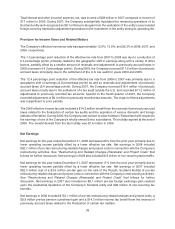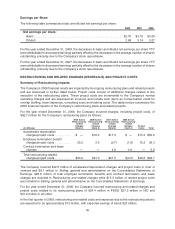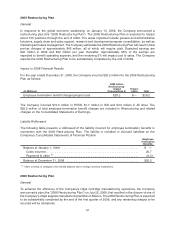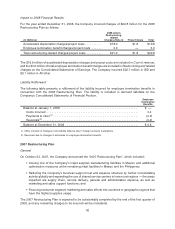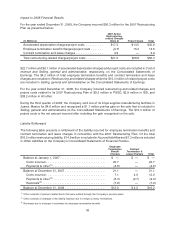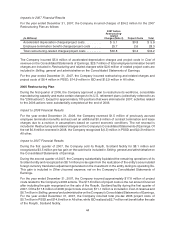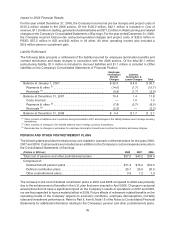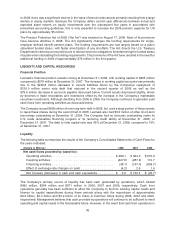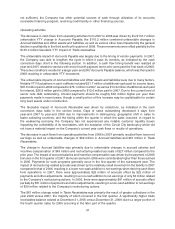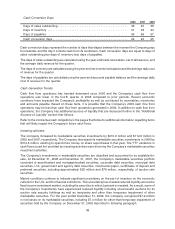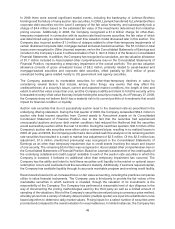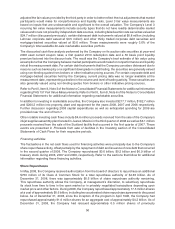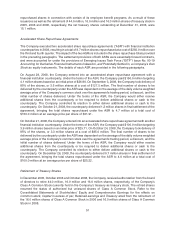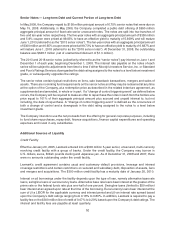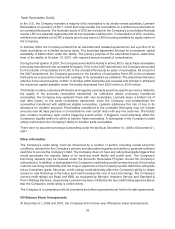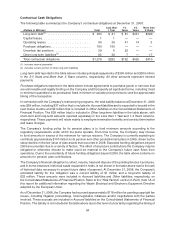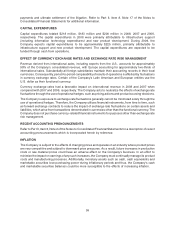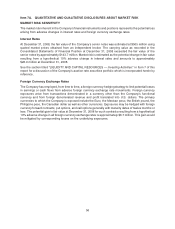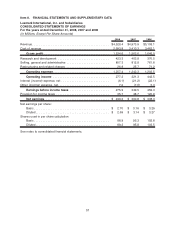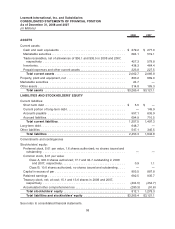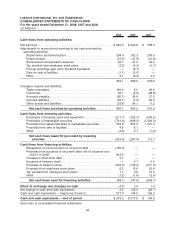Lexmark 2008 Annual Report Download - page 55
Download and view the complete annual report
Please find page 55 of the 2008 Lexmark annual report below. You can navigate through the pages in the report by either clicking on the pages listed below, or by using the keyword search tool below to find specific information within the annual report.In 2008 there were several significant market events, including the bankruptcy of Lehman Brothers
Holdings and the failure of many auction rate securities. In 2008, Lexmark transferred its Lehman Brothers
corporate debt securities into the Level 3 category of the fair value hierarchy, and subsequently took a
charge of $4.4 million based on the estimated fair value of the investments determined from indicative
pricing sources. Additionally in 2008, the Company recognized a $1.9 million charge for other-than-
temporary impairment in connection with its auction rate fixed income securities; the fair value of which
was determined using an internal discount cash flow valuation model discussed later in this section. The
Company also incurred another $1.0 million of charges related to other-than-temporary impairments of
certain distressed corporate debt, mortgage-backed and asset-backed securities. The $7.3 million in total
losses were recognized in Other (income) expense, net on the Consolidated Statements of Earnings and
included in the Company’s Level 3 rollforward table in Part II, Item 8, Note 3 of the Notes to Consolidated
Financial Statements. In addition, the Company has recognized a cumulative, pre-tax valuation allowance
of $1.7 million included in Accumulated other comprehensive loss on the Consolidated Statements of
Financial Position, representing a temporary impairment of the overall portfolio. The pre-tax valuation
allowance consists of gross unrealized losses of $8.2 million, primarily related to asset-backed and
mortgage-backed securities and corporate debt securities, offset partially by $6.5 million of gross
unrealized holding gains related mostly to US government and agency securities.
The Company assesses its marketable securities for other-than-temporary declines in value by
considering several factors that include, among other things, any events that may affect the
creditworthiness of a security’s issuer, current and expected market conditions, the length of time and
extent to which fair value is less than cost, and the Company’s ability and intent to hold the security until a
forecasted recovery of fair value that may include holding the security to maturity. As of February 27, 2009,
the Company does not believe that it has a material risk in its current portfolio of investments that would
impact its financial condition or liquidity.
Auction rate securities that do not successfully auction reset to the maximum rate as prescribed in the
underlying offering statement. During the first quarter of 2008, the Company reclassified $59.4 million in
auction rate fixed income securities from Current assets to Noncurrent assets on its Consolidated
Condensed Statement of Financial Position due to the fact that the securities had experienced
unsuccessful auctions and poor debt market conditions had reduced the likelihood that the securities
would successfully auction within the next 12 months. During the next three quarters, $40.5 million of the
Company’s auction rate securities were either sold or redeemed at par, resulting in no realized losses in
2008. At year-end 2008, the Company performed a discounted cash flow analysis on its remaining auction
rate securities that resulted in a mark to market loss adjustment of $2.5 million. Of this $2.5 million loss
adjustment, $1.9 million (mentioned previously) was recognized in the Consolidated Statements of
Earnings as an other than temporary impairment due to credit events involving the issuer and insurer
of one security. The remaining $0.6 million was recognized in Accumulated other comprehensive loss on
the Consolidated Statements of Financial Position. Based on Lexmark’s assessment of the credit quality of
the underlying collateral and credit support available to each of the auction rate securities in which the
Company is invested, it believes no additional other than temporary impairment has occurred. The
Company has the ability and intent to hold these securities until liquidity in the market or optional issuer
redemption occurs and could also hold the securities to maturity. Additionally, if Lexmark required capital,
the Company has available liquidity through its accounts receivable program and revolving credit facility.
Recent events have led to an increased focus on fair value accounting, including the practices companies
utilize to value financial instruments. The Company uses a third party to provide the fair values of the
marketable securities in which Lexmark is invested, though the valuation of its investments is the
responsibility of the Company. The Company has performed a reasonable level of due diligence in the
way of documenting the pricing methodologies used by the third party as well as a limited amount of
sampling of the valuations. Most of the Company’s securities are valued using a consensus price method,
whereby prices from a variety of industry data providers (multiple quotes) are input into a distribution-curve
based algorithm to determine daily market values. Pricing inputs for a select number of securities were
provided and compared to the overall valuation for reasonableness. In limited instances, the Company has
49


